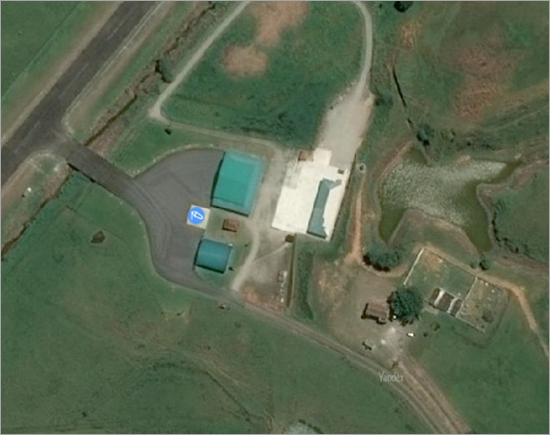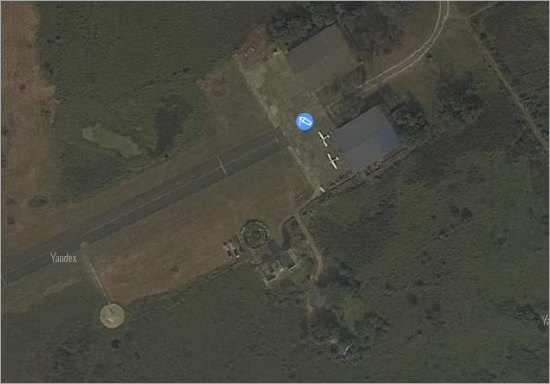3.15.1. The rules for drawing air transport items
- Airports, airfields.
- Airport terminals.
- Helicopter pads.
Techniques for drawing and editing air transport items are similar to the techniques for drawing and editing all places on YME. See the following sections:
3.15.1.1 Airports and airfields
Don't draw airport and airfield placemarks at the center of the item's territory. They are placed:
- On the main terminal building.
- If there are no passenger terminals, on the main administrative building or a building that performs that function. Note that this shouldn't be a private building (for example, the home of a private airfield owner). If there are no suitable buildings, the placemark is drawn at the center of the runway.
If there are no passenger terminals or administrative buildings, they can't be identified, or there are only private buildings, the placemark is drawn at the center of the main aircraft parking area:


- In all other cases, draw the placemark at the center of the longest runway.
Draw all functioning airports, both those that are officially open and those that are actually used. You can also draw airports that are under construction, closed, and not actually used if they meet the following conditions:
- Under construction: if the construction of runway facilities, infrastructure, terminals, and administrative buildings is completed.
- Closed and not actually used:
- If the airport or airfield is officially closed or its exact status is unknown, but it is actually used by aircrafts.
- If the airport or airfield still has at least one runway that's visible on site or in a satellite image.
Don't draw the following on the map:
- Model airplane fields.
- Parachute and paraglider landing sites.
- Airports (including those not excluded from official registers) with permanently dismantled runways or no visible traces of runways. These items can be marked up as the “Attraction” type.
3.15.1.2 Terminals
Draw all functioning passenger terminals.
Don't draw terminals that are permanently closed and no longer operational or cargo or other non-passenger terminals.
If an airport has only one terminal that doesn't have a name, don't mark it as the “Terminal” type.
As an exception, you can draw separate departure, arrival, international, and domestic sectors within this single terminal if they each have at least one separate entrance/exit.
3.15.1.3 Helicopter pads
Draw specially designated helicopter landing and takeoff points, including those located on the territory of airports, airfields, and heliports. Helicopter parking lots are not included in this category.
Heliports are marked with an airport icon (they include both official heliports and helicopter pads equipped with associated support facilities: parking lots, mini-runways, taxiways, a passenger terminal, or an administrative building).
Helicopter pads on the roofs of buildings are drawn according to the general rules, taking into account that the building polygon should align with the foundation (see Section 3.4.1.1).